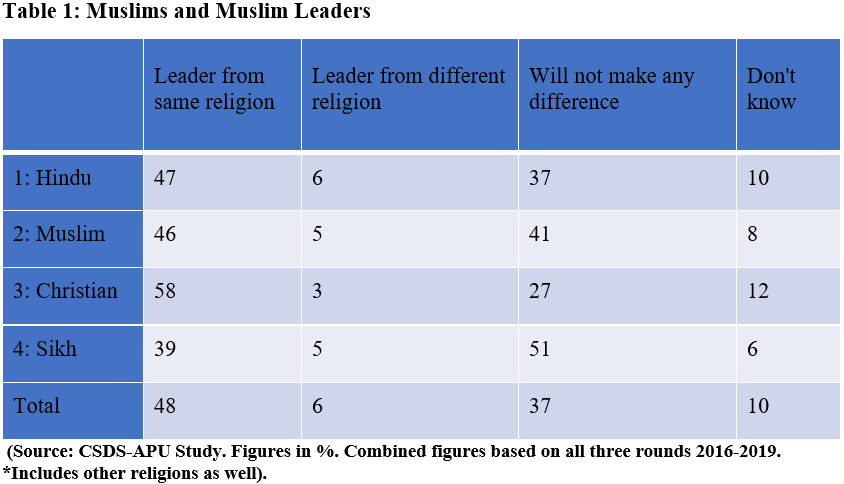Rethinking Muslim Political Representation in India
Any discussion on Muslim politics in contemporary India would remain entirely meaningless if two popular, and in a way, conflicting meanings of the term political representation were not taken into consideration. In a more general sense, Muslim representation is evoked as a normative ideal. It is argued that the adequate presence of Muslim MPs and MLAs in legislative bodies ensures the smooth and effective functioning of democratic polity. This line of argument relies heavily on the egalitarian values of the Indian Constitution as a political criterion to evaluate the representation and/or underrepresentation of Muslims in the Parliament and State Assemblies.
This normative explanation employs a highly simplistic method to determine Muslim political presence. It is assumed that there is a direct and reciprocal relationship between Muslim elected representatives and common Muslims. Thus, if the total Muslim population of India is divided by the number of elected Muslim MPs and MLAs, an exact level of Muslim representation could be ascertained. This mechanical interpretation of Muslim representation is also used to explain Muslim social marginalization and backwardness. A section of political commentators argue that Muslim underrepresentation is one of the main reasons behind the social, economic, and educational backwardness of Muslims. Highlighting the findings of the Sachar Commission Report (2006), it is strongly asserted that Muslim political representation is morally necessary and democratically desirable.
Contemporary Hindutva politics offers us another popular meaning of the term Muslim representation. BJP leaders often argue that the Indian Constitution does not recognize religion as a criterion for affirmative action, and for that matter, representation. The idea of Muslim political representation, therefore, is legally unsustainable and politically divisive. The popular slogan Sab ka Sath Sab ka Vkas, the argument goes, is sufficient to accommodate Muslims’ political aspirations.
These two popular explanations dominate our public life. Even the academic discussions on Muslim political representation are deeply influenced by these public debates. One finds a number of articles, essays, and books on this theme that reproduce such popular claims without paying any attention to the complex ways in which postcolonial Muslim political identity has evolved. In fact, the nature of competitive electoral politics and the changing dynamics of electoral representation are completely ignored in such discussions.
It is worth noting that Muslims do not participate in politics as a closed-homogeneous religious community. CSDS-Lokniti surveys show that issues such as education, employment, and healthcare determine their voting preferences in different contexts. Of course, the significance of community-based representation in political decision-making is recognized as an important factor; yet, electing only the Muslim leaders to get involved in political life is not always preferred. This complex finding—Muslim anxiety to have Muslim presence in politics versus Muslim indifference toward Muslims leaders—takes us beyond the popular stereotypical debates on Muslim representation. Precisely for this reason, there is a need to study Muslim representation in relation to three crucial aspects: political constitution of Muslim identity and its multiple manifestations, the logic of institutional set up, and the nature of Muslim leadership.
Muslim Political Identity and Representation
Muslim political identity has a complicated history. The formation of the Muslim League in colonial India and its overly communal politics—separate electorate, weightage system, and eventually two-nation theory-based demand for Partition/Pakistan—provide a strong and controversial historical context to post-independence Muslim political experiences. This historical reductionism is deeply problematic. Colonial Muslim politics, we must remember, was based on a very different logic of representation. Elite and powerful Muslims had the right to vote. These Muslim leaders claimed to represent Muslims as political custodians. The post-1951 scenario was very different. The Indian Constitution was not based on a proportional/communal form of representation. At the same time, the introduction of a universal adult franchise and first-past-the-post system of voting established a new form of political representation. The elected MPs and MLAs were to represent the community of voters living in a geographically-marked political constituency. They were supposed to represent the aspiration and demand of this secular community as committed messengers. It does not mean the Constitution was indifferent toward group rights; it recognized group rights in such a way that the principle of secularism could not be compromised. As a result, a few administrative categories—Scheduled Caste (SC), Scheduled Tribe (ST), and Minority—were created to deal with group-based collective political aspirations. There was no place for conventional Muslim politics in this framework. Muslim leaders had to evolve a new meaning of representation to get involved in the election-dominated political life of the country. In this volatile context, Muslim community as a political stakeholder was redefined.
This historical background is useful to identify two conflicting aspects of contemporary Muslim political identity. On the one hand, there are a number of culturally diversified Islamic communities that define themselves as Muslims. These Muslim communities are divided by caste, class, region, and even religious lines. The apparently heterogeneous Muslim communities engage with the electoral system in a variety of ways and produce what may be called substantive Muslimness. Muslim electoral participation at the constituency level is perhaps the best example to illustrate this point.
It does not mean that these highly diversified Muslim communities are completely fragmented nor think of themselves as “Indian Muslims” in a collective sense. The collective Muslim identity is produced in two related ways. The political class addresses Muslims as a homogeneous group—ether to legitimize their constitutional status as a religious minority or to reject them as anti-national separatists. In both cases, Muslims are seen as a homogeneous collectivity. This given oneness also affects the self-perception of Muslim communities in a significant way. They envisage themselves as members of a pan-Indian community. This process leads to a discourse of Muslimness—a discourse that revolves around the rights, privileges, duties, actions, and collective suffering of Muslims.
The political interplay between substantive Muslimness (in terms of diversity) and discourse of Muslimness (in terms of homogeneity) actually determine the nature of political representation in a significant way. For example, Asaduddin Owaisi has carved out a space for himself as a Muslim leader in the media-dominated discourse. A large number of Muslims attend his rallies and public meetings all over the country. However, despite this popular backing, Owaisi’s party, the All India Ittehadul Muslimeen (AIMIM) has not yet been able to translate this overwhelming Muslim enthusiasm into electoral benefits. Muslims reject AIMIM at the constituency level because its religious appeal does not always correspond to complex sociological and economic configurations at the constituency level. In other words, Owaisi becomes a representative of all Muslims when he operates in the discourse of Muslimness. However, he remains an insignificant factor at the constituency level outside Hyderabad (or for that matter, where his party does not have any organic link with voters). It means substantive Muslimness produces a different context-specific logic of representation.
Representation and Institutional Framework
Politics of Muslim representation is inextricably linked to the institutional structures that governs the operational aspects of competitive electoral politics. The direct election based on universal adult franchise for the Lok Sabha and State Assemblies actually encouraged the political parties to constitute the winning configurations of voters. The KHAM (Kshatriya, Harijan, Adivasi, Muslim) model in pre-Modi Gujarat and MY (Muslim-Yadav) model in UP and Bihar in the post-Babri Masjid scenario are good examples of such political coalitions of voting communities. The BJP’s emergence as the dominant player over the last eight years has broken these configurations in a powerful manner. The party tends to create a new configuration of voters in which it does not want to include Muslims. This exclusion of Muslims from the winning configuration is one of the most crucial aspects of contemporary electoral politics.
It is worth noting that the members of Rajya Sabha and State Councils are not elected directly. These legislative bodies offer an opportunity for the political party to induct their favorable Muslim leaders in the Parliament and state legislative. This indirect form of election is used by the political class to fulfil its commitment to wider inclusion. My 2015 study, “Muslim Representation in Rajya Sabha: Forms and Trajectories,” shows that unlike the Lok Sabha, Muslim representation in the Rajya Sabha has always been impressive (9-10 percent). This is an important finding, revealing that Muslim representation, even in terms of the number of MPs and MLAs, is contingent upon the actual institutional set up of legislative bodies.
Representation and Leadership
Muslim representation, in any case, is all about leadership function. The 2017-19 CSDS Lokniti-APU’s three-round survey-based study, “Politics and Society Between Elections,” covers 24 states with a nationally representative sample of more than 48,000 respondents.
One particular question is very significant: “Suppose there are two leaders from same political party and equally competent to get your work done. If one is from your religion while the other from a different religion, whom would you be willing to contact first?”

Table 1 shows a mixed response on this question. It appears that religious groups do not necessarily trust the leaders of their own respective communities. Muslim perceptions also confirm this general pattern. 46 percent of Muslim respondents claimed they would prefer to contact a Muslim leader if they were in need. However, almost an equal number of Muslims (41 percent) did not subscribe to this view. For them, religion of a leader is not an important consideration.
Two crucial inferences can be drawn from these findings. It is clear that Muslim communities do recognize the importance of having Muslim elected leaders to deal with everyday encounters with administrative power structured in a different context. Secondly, Muslim leaders are not always seen as representatives. Instead, they are envisaged as professional politicians who participate in politics to maximize their vested interests.
A close analysis of these trends suggests that Muslim leadership, in and of itself, is a highly diversified phenomenon. There are three distinct types of Muslim leaders who perform very specific functions in different contexts: Professional Muslim politicians, Muslim elites, and Muslim influencers. The professional Muslim politicians operate as a crucial link between parties and the particular Muslim community they claim to represent. The Muslim elite, on the other hand, functions as a systemizer—either to sustain the internal power structure in its favor or to challenge it to get legitimacy. The influencer asserts his/her presence in the media-driven public discourse. These three types of leaders perform very specific functions in different political contexts and produce concrete everyday meanings of Muslim representation, which are very different from popular perceptions and media debates.
This article is the final in a five-part series of guest-edited IiT short series. The articles in this series attempt to map out various facets of Muslim political presence in contemporary India. More precisely, five thematic issues related to Muslim identity are systematically investigated: (a) Emergence of religion as an official category and its impact on competitive electoral politics. (b) The ever fluctuating legal-constitutional meanings of the term minority. (c) The nature of anti-Muslim violence and official response to it. (d) The changing political attitude of non-BJP parties. And finally, (e) Relevance of Muslim political representation in today’s India. In this sense, this series offers a different intellectual perspective to what is usually defined as Indian Muslim politics. The pieces in this series collectively assert that Muslim politics is not simply about the number of Muslim MPs and MLAs, nor is it entirely reducible to the voting behavior of Muslim electorates. The political engagements of Muslims, we argue, must be explored as an ever-evolving independent political discourse, which is not always primarily shaped by responses to the challenges posed by Hindutva politics. In this sense, the idea of New India, an official doctrine adopted by the BJP-led NDA regime as a policy framework, is recognized as a significant reference point. For this reason, we treat it as a watershed moment of Indian politics.
(Guest Editor: Hilal Ahmed, Associate Professor, CSDS, New Delhi; Associate Editor, South Asian Studies, journal of the British Association of South Asian Studies, UK)

